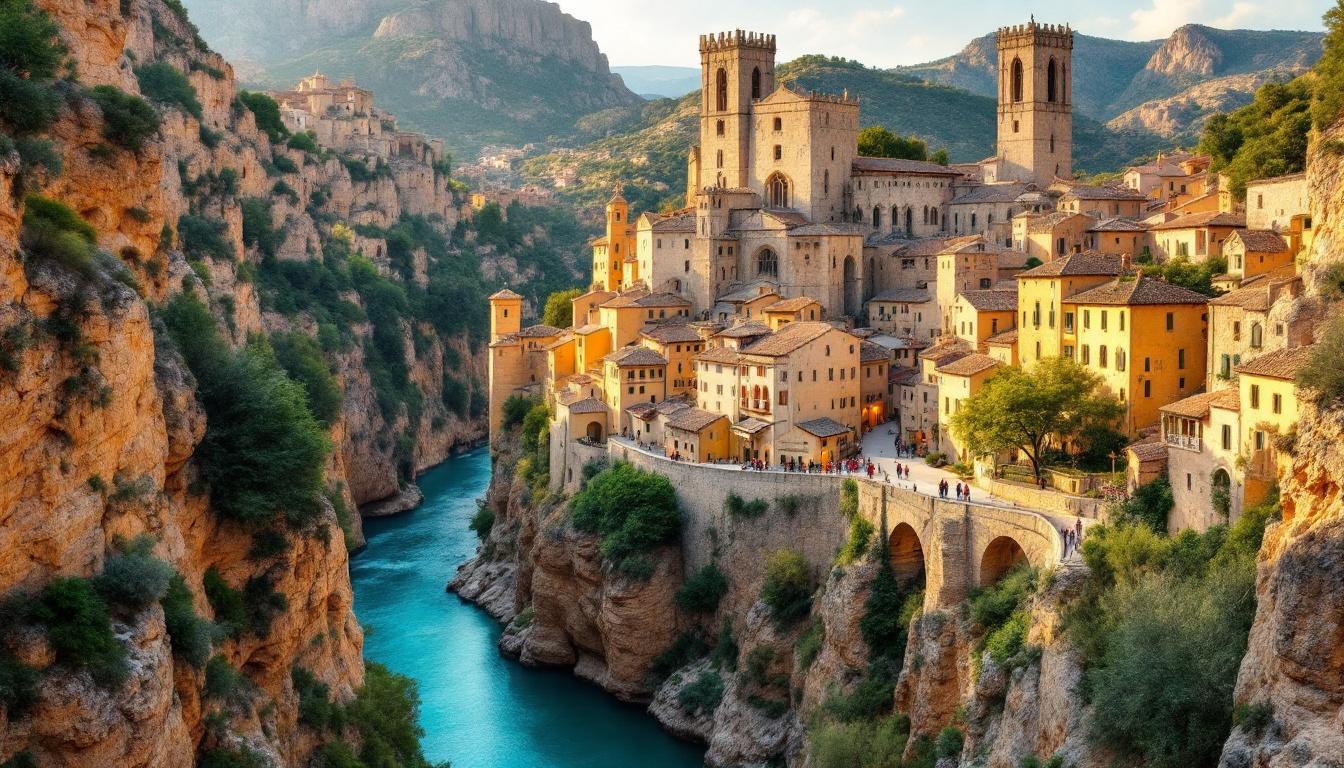Deep in the Hérault gorges, where medieval stone bridges span ancient riverbeds, lies the only French village where UNESCO pilgrims still follow routes carved by 12th-century feet. Saint-Guilhem-le-Désert stands as France’s singular intersection of sacred heritage and living pilgrimage tradition.
While Rocamadour draws crowds and Conques sells postcards, this 243-soul village guards something irreplaceable. The Gellone Abbey houses relics of the True Cross, gifted by Charlemagne himself, attracting pilgrims who traverse the same Via Tolosana paths their ancestors walked over 1,000 years ago.
What makes this village absolutely unique isn’t just its beauty. It’s the only place in France where UNESCO World Heritage status meets active Camino de Santiago routes, creating an authentic pilgrimage experience impossible to find elsewhere.
The sacred convergence that exists nowhere else
UNESCO abbey meets living pilgrimage routes
Gellone Abbey stands as the only UNESCO World Heritage abbey directly positioned on active Camino de Santiago pathways. The Via Tolosana (GR 653) brings modern pilgrims through the same Hérault Valley passages used since 1000 AD, stopping at an abbey that houses Saint Guilhem’s actual bones and fragments of Christ’s cross.
Medieval paths still marked for modern pilgrims
Follow the white-red GR markers through Mediterranean scrublands, and you’re walking identical routes to medieval travelers. The 340-kilometer Chemin de Saint-Guilhem-le-Désert connects Aubrac’s highlands to this gorge sanctuary, while the ancient Pont du Diable (built 873 AD) still carries pilgrims across the Hérault River exactly as intended.
Authentic pilgrimage experience vs tourist attractions
Living spiritual tradition over commercialized sites
Unlike Rocamadour’s tourist crowds or Carcassonne’s 8 million annual visitors, Saint-Guilhem maintains authentic pilgrimage atmosphere. Real pilgrims sleep in the village’s modest accommodations, attend morning prayers at Gellone Abbey, and continue their spiritual journeys following shell-marked fountain trails through the gorges.
Protected UNESCO status preserving sacred authenticity
The village’s “Grand Site de France” designation strictly limits development around the abbey and natural gorges. Controlled parking fees and seasonal tourism office hours prioritize pilgrimage needs over casual tourism, ensuring the spiritual atmosphere remains undisturbed by mass commercial interests.
Historical exclusivity spanning twelve centuries
Charlemagne’s personal religious gift creating pilgrimage destination
Emperor Charlemagne’s gift of True Cross fragments to his cousin Saint Guilhem in 804 AD established this location’s unique spiritual significance. No other French Camino stop possesses such direct imperial religious connections, making pilgrimages here encounters with verified sacred relics rather than symbolic destinations.
Continuous pilgrimage tradition through medieval routes
The Via Tolosana has channeled pilgrims through these exact gorge passages for over 1,200 years without interruption. Modern pilgrims following GR 653 markers experience identical landscape approaches, river crossings, and abbey approaches that medieval travelers documented in their spiritual journals.
Protected local management preserving pilgrimage integrity
Community-controlled tourism maintaining spiritual atmosphere
Local policies deliberately limit visitor numbers through €5-6 daily parking fees and restricted access points. The intercommunal tourism office operates reduced winter hours, prioritizing residents’ needs and maintaining the contemplative silence essential for authentic pilgrimage experiences.
Natural barriers creating exclusive access
The Hérault gorges naturally restrict access to serious pilgrims and dedicated travelers. Limited road connections and challenging terrain deter casual tourists while welcoming those following official Camino routes with proper preparation and spiritual motivation.
Planning your authentic pilgrimage experience
What makes Saint-Guilhem different from other pilgrimage sites?
Saint-Guilhem-le-Désert is the only French village where UNESCO World Heritage Gellone Abbey sits directly on active Camino de Santiago routes, creating authentic medieval pilgrimage experiences impossible to replicate at commercialized sites like Rocamadour or tourist-focused locations.
When should pilgrims visit for the most authentic experience?
Late spring and early autumn offer ideal conditions with fewer crowds and mild weather. Summer brings peak pilgrimage season but maintains spiritual atmosphere due to local tourism management policies that prioritize authentic religious travelers over casual visitors.
How do modern pilgrims follow the medieval routes?
Follow GR 653 white-red markers along the Via Tolosana, or take the 340-kilometer Chemin de Saint-Guilhem-le-Désert from Aubrac. Both routes converge at the village using identical pathways documented in medieval pilgrimage records.
Saint-Guilhem-le-Désert offers what no other French village can: the intersection of living UNESCO heritage with authentic Camino pilgrimage routes. Here, sacred tradition continues unbroken through twelve centuries of spiritual seekers.
This isn’t just another beautiful French village. It’s the only place where medieval pilgrimage dreams become modern spiritual reality, protected by locals who understand that some treasures are worth preserving exactly as they’ve always been.
